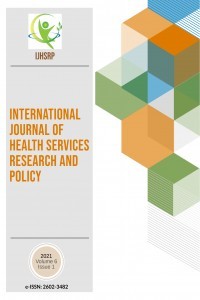VIOLENCE AGAINST HEALTH CARE WORKERS: A RETROSPECTIVE STUDY
VIOLENCE AGAINST HEALTH CARE WORKERS: A RETROSPECTIVE STUDY
As violence in society is increasing in recent years it is an important problem in healthinstitutions as well. Changes in health systems, rising socio-economic levels of people, and changes inexpectations for health services led to violence in health sector. This study was conducted for thepurpose of examining work place violence against health care workers. This retrospective-descriptivestudy covers a period from December 2011 to April 2015. 136 notifications about work place violencereported by health workers to quality management unit of a hospital were taken into account.Research findings show that 43,4% of the victims of violence was physicians, 37,5% was nurses andhealth officers and 19,1% were from other professions. 63,2% of the health workers were women,36,8% were male. Additionally health workers were exposed to violence by 47.3% of the patients and52.7% by their relatives. 69.7% of the people applied violence were male and 30.3% were female.63,2% of the health workers exposed to violence were women, 36,8% were male. According to ourresults male physicians were exposed to workplace violence more than other workers and this wassignificant ( χ 2=31,634, p<0,01).When place of violence occurred was investigated it was seen that while most of physicianswere exposed to violence in polyclinics, nurses were exposed to violence in inpatient services(χ2=18,231, p<0,01). Male physicians were exposed to verbal violence most. On the other handnurses experienced both verbal and physical violence (χ2=34,639,p<0.01). Patient relatives appliedverbal violence and the others applied physical violence (χ2=22,073, p<0,01).As a result, in order to reduce / prevent violence in work place , it is considered necessary toincrease consciousness of patients and their relatives, to increase security measures in healthinstitutions, to provide health workers to report work place violence to management , to improvephysical working conditions and increase legal sanctions in terms of providing employee safety.
Keywords:
Health Workers Health institution, Employee Safety,
___
- [1] Krug, E. G., et al., World Report on Violence and Health, World Health Organization, Geneva, 2002
- [2] Çamcı, O., Kutlu, Y., Kocaeli’nde Sağlık Çalışanlarına Yönelik İşyeri Şiddetinin Belirlenmesi, Psikiyatri Hemşireliği Dergisi, 2 (2011) 1, pp. 9-16
- [3] Demir, G., Bir Üniversite Hastanesinde Çalışan Hemşirelerin Şiddete Maruz Kalma Durumlarının İncelenmesi, İnönü Üniversitesi Sağlık Bilimleri Dergisi, 3 (2014), 1, pp. 25-28
- [4] İlhan, M. N., et al., Toplum Gözüyle Sağlık Çalışanlarına Şiddet: Nedenler, Tutumlar, Davranışlar, Gazi Medical Journal, 24 (2013), pp. 5-10
- [5] International Labour Organization (ILO), et al., Framework Guidelines For Addressing Workplace Violence in The Health Sector. International Labour Office, Geneva, 2002
- [6] Al, B., et al., Sağlık Çalışanlarına Yönelik Artan Şiddet, The Journal of Academic Emergency Medicine, 11 (2012), pp. 115-24
- [7] Annagür B., Sağlık Çalışanlarına Yönelik Şiddet: Risk Faktörleri, Etkileri, Değerlendirilmesi ve Önlenmesi, Psikiyatride Güncel Yaklaşımlar, 2 (2010), 2, pp. 161-173
- [8] Cinoğlu, A., Sağlık Kurumlarında Şiddet, Dönem Projesi, Pamukkale Üniversitesi, Denizli, Türkiye, 2015
- [9] Kahriman İ., Hemşirelerin Sözel ve Fiziksel Şiddete Maruz Kalma Durumlarının Belirlenmesi, Psikiyatri Hemşireliğ iDergisi, 5 (2014), 2, pp. 77-83
- [10] Pınar, T., Pınar G., Sağlık Çalışanları ve İşyerinde Şiddet, TAF Preventive Medicine Bulletin, 12 (2012), 3, pp. 315-326
- [11] Akca, N., et al., Sağlık Çalışanlarına Uygulanan Şiddet: Özel Bir Tıp Merkezi Örneği, Ankara SağlıkHizmetleriDergisi, 13 (2014), 1, pp. 1-12
- [12] Durak, T. Ç., et al., Bozyaka Eğitim ve Araştırma Hastanesi Sağlık Çalışanlarına Hasta ve Hasta Yakınları Tarafından Uygulanan Şiddetin Değerlendirilmesi, Genel Tıp Dergisi, 24 (2014), pp. 130-137
- [13] Sarcan, E., Toplumun Sağlık Çalışanlarına Uygulanan Şiddete Bakış Açısı, UzmanlıkTezi, Gazi Üniversitesi, Ankara, Türkiye, 2013
- [14] Ayrancı, Ü., et al., Çeşitli Sağlık Kurumlarında ve Sağlık Meslek Gruplarında Şiddete Uğrama Sıklığı, Anadolu Psikiyatri Dergisi, 3 (2002), pp. 147-154
- [15] Gülalp, B., et al., Dangers Faced By Emergency Staff: Experience In Urban Centers In Southern Turkey, Turkish Journal of Trauma&Emergency Surgery, 15 (2009), 3, pp. 239-242
- [16] Sağlık ve Sosyal Hizmet Çalışanları Sendikası, Sağlık Çalışanları Şiddet Araştırması, Sağlık- Sen Yayınları-20, Ankara, 2013
- [17] Arcak R.Kasımoğlu; E., Diyarbakır Merkezdeki Hastane ve Sağlık Ocaklarında Çalışan Hemşirelerin Sağlık Hizmetlerindeki Rolü ve İş Memnuniyetleri, Dicle Tıp Dergisi,1(2006), 3, pp. 323-330.
- [18] Winstanley, S., Whittington, R., Aggression Towards Health Care Staff In A UK General Hospital: Variation Among Professions and Departments, Journal of Clinical Nursing, 13 (2004), 1, pp. 3-10
- [19] Özcan, N. K., Bilgin, H., Türkiye’de Sağlık Çalışanlarına Yönelik Şiddet: Sistematik Derleme. Türkiye Klinikleri Tıp Bilimleri Dergisi, 31 (2011), 6, pp. 1442-56
- Yayın Aralığı: Yılda 3 Sayı
- Başlangıç: 2016
- Yayıncı: Rojan GÜMÜŞ
